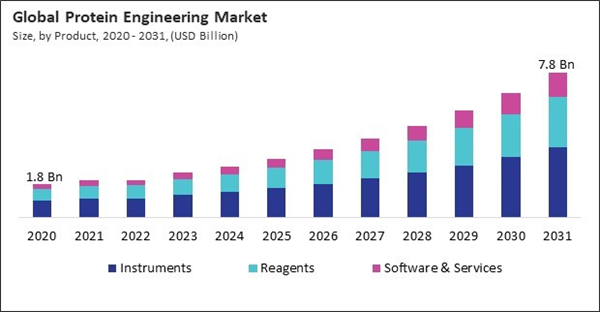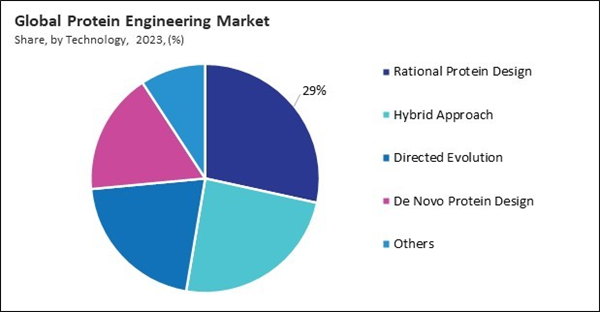The Global Protein Engineering Market size is expected to reach $7.8 billion by 2031, rising at a market growth of 16.0% CAGR during the forecast period.
Protein engineering is crucial in developing and optimizing growth factors, signaling proteins that regulate cell growth, proliferation, and differentiation. This engineering has been used to develop novel growth factors with enhanced specificity and potency. Consequently, the growth factors segment would acquire nearly 12% of the total market share by 2031. To enhance its effectiveness in promoting blood vessel formation, for instance, scientists have engineered variants of vascular endothelial growth factor (VEGF), a key regulator of angiogenesis.
By abandoning the conventional "one-size-fits-all" approach in favor of a more individualized treatment paradigm, personalized medicine is currently transforming the healthcare infrastructure. Personalized medicine harnesses the power of genomic and molecular data to guide clinical decisions. By analyzing a patient's genetic profile, healthcare providers can identify specific genetic mutations, biomarkers, and pathways involved in their disease. Therefore, with the continuous evolution of this engineering and genomic technologies, the potential for personalized medicine to revolutionize healthcare and enhance patient outcomes will inevitably expand, propelling the market's expansion. Additionally, Innovations in technologies like CRISPR, synthetic biology, and computational protein design enhance the ability to engineer proteins with desired characteristics. Synthetic biology has been used to engineer yeast and bacteria to produce complex pharmaceuticals like artemisinin, an antimalarial drug, which traditionally had a complex and costly extraction process from plants. Thus, the advancements in this engineering technologies like CRISPR, synthetic biology, and computational protein design are driving significant growth in the market.
The COVID-19 pandemic accelerated the digital transformation of the healthcare industry, leading to greater utilization of computational tools and artificial intelligence in this engineering. This digitalization brought the potential to streamline this engineering process, reduce development timelines, and enhance the efficiency of drug discovery and development efforts. The demand for engineering solutions that leverage these technologies grew as the healthcare industry embraced digital technologies. Therefore, the pandemic had an overall positive impact on the market.
However, Developing engineered proteins requires substantial investment in various areas, including advanced laboratory equipment, skilled personnel, research materials, and infrastructure. Personnel costs also contribute significantly to the engineering R&D. Recruiting and retaining skilled scientists, biotechnologists, and bioinformaticians proficient in this engineering techniques can be costly, especially in regions with high competition for talent. Hence, these factors may hamper the growth of the market.
Protein engineering is crucial in developing and optimizing growth factors, signaling proteins that regulate cell growth, proliferation, and differentiation. This engineering has been used to develop novel growth factors with enhanced specificity and potency. Consequently, the growth factors segment would acquire nearly 12% of the total market share by 2031. To enhance its effectiveness in promoting blood vessel formation, for instance, scientists have engineered variants of vascular endothelial growth factor (VEGF), a key regulator of angiogenesis.
By abandoning the conventional "one-size-fits-all" approach in favor of a more individualized treatment paradigm, personalized medicine is currently transforming the healthcare infrastructure. Personalized medicine harnesses the power of genomic and molecular data to guide clinical decisions. By analyzing a patient's genetic profile, healthcare providers can identify specific genetic mutations, biomarkers, and pathways involved in their disease. Therefore, with the continuous evolution of this engineering and genomic technologies, the potential for personalized medicine to revolutionize healthcare and enhance patient outcomes will inevitably expand, propelling the market's expansion. Additionally, Innovations in technologies like CRISPR, synthetic biology, and computational protein design enhance the ability to engineer proteins with desired characteristics. Synthetic biology has been used to engineer yeast and bacteria to produce complex pharmaceuticals like artemisinin, an antimalarial drug, which traditionally had a complex and costly extraction process from plants. Thus, the advancements in this engineering technologies like CRISPR, synthetic biology, and computational protein design are driving significant growth in the market.
The COVID-19 pandemic accelerated the digital transformation of the healthcare industry, leading to greater utilization of computational tools and artificial intelligence in this engineering. This digitalization brought the potential to streamline this engineering process, reduce development timelines, and enhance the efficiency of drug discovery and development efforts. The demand for engineering solutions that leverage these technologies grew as the healthcare industry embraced digital technologies. Therefore, the pandemic had an overall positive impact on the market.
However, Developing engineered proteins requires substantial investment in various areas, including advanced laboratory equipment, skilled personnel, research materials, and infrastructure. Personnel costs also contribute significantly to the engineering R&D. Recruiting and retaining skilled scientists, biotechnologists, and bioinformaticians proficient in this engineering techniques can be costly, especially in regions with high competition for talent. Hence, these factors may hamper the growth of the market.
Driving and Restraining Factors
Drivers- Emergence of personalized medicine
- Advancements in protein engineering technologies
- Increasing prevalence of chronic diseases
- High costs of research and development
- Challenges in protein folding, stability, and expression
- Rising investment in biotechnology and pharmaceuticals
- Expanding applications in industrial and environmental sectors
- Issues associated with intellectual property
- Long development timelines and uncertainty in clinical outcomes
Product Outlook
Based on product, the market is characterized into instruments, reagents, and software & services. The reagents segment procured 35% revenue share in the market in 2023. Reagents, including enzymes, antibodies, buffers, and substrates, are essential in the engineering experiments. The increasing adoption of recombinant DNA technology and protein expression systems has driven the demand for high-quality reagents, supporting the growth of this segment.End-use Outlook
Based on end-use, the market is segmented into academic research institutes, contract research organizations (CROs), pharmaceutical & biotechnology companies. The contract research organizations (CROs) segment witnessed 38.5% revenue share in the market in 2023. CROs are vital in providing the engineering services to pharmaceutical, biotechnology, and academic research institutions, offering expertise and resources for protein design, expression, purification, and characterization.Technology Outlook
On the basis of technology, the market is classified into rational protein design, directed evolution, hybrid approach, de novo protein design, and others. The hybrid approach segment recorded 34.2% revenue share in the market in 2023. The hybrid approach combines elements of rational protein design and directed evolution, leveraging computational modeling and experimental evolution to engineer proteins with improved or novel functions.Protein Type Outlook
By protein type, the market is divided into insulin, monoclonal antibodies, vaccines, growth factors, colony stimulating factors, coagulation factors, interferon, and others. The insulin segment garnered 16.75% revenue share in the market in 2023. Insulin, a life-saving therapeutic protein for diabetic patients, exemplifies the crucial role of this engineering in chronic disease management. The engineering advancements have produced a variety of insulin formulations that more closely resemble the body's endogenous insulin secretion.Regional Outlook
Region-wise, the market is analyzed across North America, Europe, Asia Pacific, and LAMEA. The North America segment garnered 39.8% revenue share in the market in 2023. The region's strong biotechnology and pharmaceutical sectors, in addition to substantial investments in the engineering research and development, are factors contributing to this.List of Key Companies Profiled
- Agilent Technologies, Inc.
- Bruker Corporation
- Thermo Fisher Scientific, Inc.
- Waters Corporation
- Bio-Rad Laboratories, Inc.
- Merck KGaA
- Danaher Corporation
- Genscript Biotech Corporation
- Amgen, Inc.
- Promega Corporation
Market Report Segmentation
By Product- Instruments
- Reagents
- Software & Services
- Pharmaceutical & Biotechnology Companies
- Contract Research Organizations (CROs)
- Academic Research Institutes
- Rational Protein Design
- Hybrid Approach
- Directed Evolution
- De Novo Protein Design
- Others
- Monoclonal Antibodies
- Insulin
- Vaccines
- Growth Factors
- Interferon
- Colony Stimulating Factors
- Coagulation Factors
- Others
- North America
- US
- Canada
- Mexico
- Rest of North America
- Europe
- Germany
- UK
- France
- Russia
- Spain
- Italy
- Rest of Europe
- Asia Pacific
- China
- Japan
- India
- South Korea
- Singapore
- Malaysia
- Rest of Asia Pacific
- LAMEA
- Brazil
- Argentina
- UAE
- Saudi Arabia
- South Africa
- Nigeria
- Rest of LAMEA
Table of Contents
Chapter 1. Market Scope & Methodology
Chapter 2. Market at a Glance
Chapter 3. Market Overview
Chapter 4. Global Protein Engineering Market by Product
Chapter 5. Global Protein Engineering Market by End-use
Chapter 6. Global Protein Engineering Market by Technology
Chapter 7. Global Protein Engineering Market by Protein Type
Chapter 8. Global Protein Engineering Market by Region
Chapter 9. Company Profiles
Companies Mentioned
- Agilent Technologies, Inc.
- Bruker Corporation
- Thermo Fisher Scientific, Inc.
- Waters Corporation
- Bio-Rad Laboratories, Inc.
- Merck KGaA
- Danaher Corporation
- Genscript Biotech Corporation
- Amgen, Inc.
- Promega Corporation
Methodology

LOADING...










